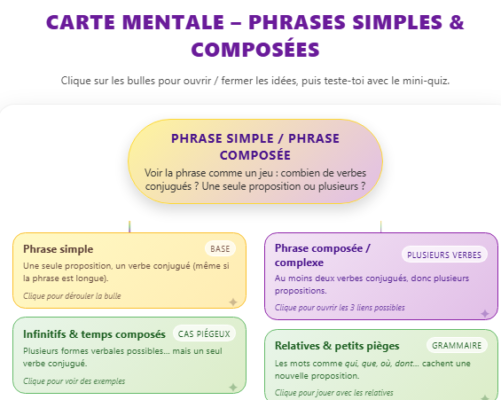Guide : 70 Connecteurs Logiques en Anglais à Connaître
Recommandés
Ce guide présente 70 connecteurs logiques essentiels en anglais, classés par catégories avec des exemples et des codes couleur pour faciliter leur utilisation.
1. Connecteurs d’Addition (Addition) 🟦 (Bleu)
Connecteurs : And, Also, Moreover, Furthermore, In addition, Not only… but also, Besides, Plus, What’s more
Exemples :
- « She is very talented. Moreover, she works hard. »
- « They hired new staff. In addition, they renovated the office. »
2. Connecteurs de Cause et Effet (Cause and Effect) 🟨 (Jaune)
Connecteurs : Because, Since, As, So, Therefore, Thus, Hence, As a result, Consequently, For this reason
Exemples :
- « Since he was late, the meeting was postponed. »
- « The sales were low. As a result, the company suffered losses. »
3. Connecteurs de Comparaison et Contraste (Comparison and Contrast) 🟧 (Orange)
Connecteurs : Similarly, Likewise, On the other hand, However, Nevertheless, Whereas, While, Yet, In contrast, Conversely
Exemples :
- « Similarly, this solution could work for other departments. »
- « The city is beautiful. However, it is very crowded. »
4. Connecteurs de Temps (Time) 🟩 (Vert)
Connecteurs : Before, After, While, When, As, Meanwhile, Subsequently, Thereafter, At the same time, Earlier, Later
Exemples :
- « While he was speaking, the audience listened carefully. »
- « They discussed the issue. Subsequently, a solution was proposed. »
5. Connecteurs d’Accentuation (Emphasis) 🟥 (Rouge)
Connecteurs : Indeed, In fact, Of course, Without a doubt, Certainly, Obviously, Clearly, Most importantly, Above all
Exemples :
- « Indeed, this approach has proven to be the most effective. »
- « Most importantly, we need to prioritize customer satisfaction. »
6. Connecteurs d’Exemple (Example) 🟪 (Violet)
Connecteurs : For example, For instance, Such as, To illustrate, Namely, In particular, Specifically, Including
Exemples :
- « Some countries, such as France and Germany, have implemented this policy. »
- « For example, let’s consider the case of renewable energy. »
7. Connecteurs de Conclusion (Conclusion) ⚫ (Noir)
Connecteurs : In conclusion, To sum up, To summarize, Finally, Ultimately, In summary, On the whole, In short
Exemples :
- « In conclusion, this strategy will benefit all stakeholders. »
- « Finally, let’s move on to the last item on the agenda. »
8. Connecteurs de Condition (Condition) 🟫 (Marron)
Connecteurs : If, Unless, Provided that, As long as, On condition that, In case, Even if, Only if, Otherwise
Exemples :
- « If we reduce costs, we can achieve higher profitability. »
- « Unless we address this issue, it will escalate. »
9. Connecteurs de Clarification (Clarification) 🟨 (Doré)
Connecteurs : In other words, That is, To clarify, Namely, Put differently, To put it another way
Exemples :
- « The instructions were unclear. To clarify, the deadline is tomorrow. »
- « In other words, we need more time to complete this project. »
10. Connecteurs de Contraste Subtil (Subtle Contrast) 🟦 (Bleu ciel)
Connecteurs : On the one hand… on the other hand, Even so, Still, Though, Although, Yet, Albeit
Exemples :
- « Even so, we managed to deliver the project on time. »
- « The proposal is solid. Yet, some adjustments are needed. »
11. Connecteurs de Référence (Reference) 🟪 (Rose)
Connecteurs : According to, As mentioned, Referring to, As stated by, With respect to, As per
Exemples :
- « According to the report, sales increased by 15%. »
- « As stated by the manager, the new policy will be implemented next month. »
Voici une liste élargie avec 70 connecteurs logiques essentiels en anglais, regroupés par catégorie et accompagnés d’exemples concrets pour chaque connecteur.
1. Addition (Ajout) 🟦 (Bleu)
- And
- Also
- Moreover
- Furthermore
- In addition
- Not only… but also
- Besides
- Plus
- What’s more
- Additionally
Exemples :
- « She is kind. Moreover, she is very intelligent. »
- « The report is accurate. In addition, it provides clear solutions. »
2. Cause and Effect (Cause et Effet) 🟨 (Jaune)
- Because
- Since
- As
- So
- Therefore
- Thus
- Hence
- As a result
- Consequently
- For this reason
Exemples :
- « He missed the deadline. As a result, his manager was disappointed. »
- « She was late because her car broke down. »
3. Comparison and Contrast (Comparaison et Contraste) 🟧 (Orange)
- Similarly
- Likewise
- On the other hand
- However
- Nevertheless
- Nonetheless
- Whereas
- While
- Yet
- In contrast
Exemples :
- « Both strategies are effective. Similarly, they require teamwork. »
- « However, the second approach might be more cost-effective. »
4. Time (Temps) 🟩 (Vert)
- Before
- After
- While
- When
- As
- Meanwhile
- Subsequently
- Thereafter
- At the same time
- Earlier
Exemples :
- « Meanwhile, the team continued to work on the project. »
- « We will leave after the meeting. »
5. Emphasis (Accentuation) 🟥 (Rouge)
- Indeed
- In fact
- Of course
- Without a doubt
- Certainly
- Obviously
- Clearly
- Undoubtedly
- Above all
- Most importantly
Exemples :
- « Indeed, this is the most efficient solution. »
- « This is, without a doubt, the best option. »
6. Example (Exemple) 🟪 (Violet)
- For example
- For instance
- Such as
- To illustrate
- Namely
- In particular
- Specifically
- Including
- As an example
- Particularly
Exemples :
- « For instance, renewable energy sources like solar and wind are sustainable. »
- « Many countries, such as Germany and Norway, invest heavily in green energy. »
7. Conclusion (Conclusion) ⚫ (Noir)
- In conclusion
- To sum up
- To summarize
- Finally
- Ultimately
- In summary
- On the whole
- In short
- All in all
- To conclude
Exemples :
- « To sum up, the new policy will save costs and improve efficiency. »
- « Finally, let’s address any remaining questions. »
Résumé des Connecteurs
| Catégorie | Connecteurs |
|---|---|
| Addition | And, Also, Moreover, Furthermore, In addition, Not only… but also, Besides, Plus, What’s more, Additionally |
| Cause and Effect | Because, Since, As, So, Therefore, Thus, Hence, As a result, Consequently, For this reason |
| Comparison/Contrast | Similarly, Likewise, On the other hand, However, Nevertheless, Nonetheless, Whereas, While, Yet, In contrast |
| Time | Before, After, While, When, As, Meanwhile, Subsequently, Thereafter, At the same time, Earlier |
| Emphasis | Indeed, In fact, Of course, Without a doubt, Certainly, Obviously, Clearly, Undoubtedly, Above all, Most importantly |
| Example | For example, For instance, Such as, To illustrate, Namely, In particular, Specifically, Including, As an example, Particularly |
| Conclusion | In conclusion, To sum up, To summarize, Finally, Ultimately, In summary, On the whole, In short, All in all, To conclude |
Ci-après une explication des connecteurs logiques par catégorie, avec des exemples concrets pour illustrer leur utilisation dans différents contextes.
1. Addition (Ajout)
Ces connecteurs servent à ajouter une idée ou une information supplémentaire.
- And : Utilisé pour ajouter une idée.
Exemple : « She likes reading and writing. » - Moreover / Furthermore : Renforcent l’idée précédente.
Exemple : « The project is on time. Moreover, it’s under budget. » - In addition : Ajoute une information.
Exemple : « They renovated the office. In addition, they hired new staff. » - Besides : Utilisé pour introduire un argument supplémentaire.
Exemple : « Besides, it’s an excellent opportunity. »
2. Cause and Effect (Cause et Effet)
Ces connecteurs montrent une relation de cause à effet.
- Because / Since / As : Introduisent la cause.
Exemple : « The meeting was delayed because of traffic. » - Therefore : Présente une conséquence logique.
Exemple : « He worked hard; therefore, he succeeded. » - Thus / Hence : Soulignent une conclusion ou une conséquence.
Exemple : « The experiment failed; thus, we need a new approach. »
3. Comparison and Contrast (Comparaison et Contraste)
Ces connecteurs comparent des idées ou montrent des différences.
- Similarly / Likewise : Montrent des similitudes.
Exemple : « The first solution worked. Similarly, the second was successful. » - However / Nevertheless : Introduisent une opposition.
Exemple : « He is talented. However, he lacks experience. » - While / Whereas : Contraste entre deux idées.
Exemple : « She prefers tea, while he likes coffee. »
4. Time (Temps)
Ces connecteurs montrent des relations temporelles entre des événements.
- Before / After : Marquent l’ordre des événements.
Exemple : « Finish your homework before you watch TV. » - Meanwhile : Pendant ce temps.
Exemple : « She was cooking. Meanwhile, he set the table. » - Subsequently / Thereafter : Indiquent une suite.
Exemple : « He graduated in 2018. Subsequently, he started his career. »
5. Emphasis (Accentuation)
Ces connecteurs insistent sur une idée ou un point important.
- Indeed : Renforce une affirmation.
Exemple : « Indeed, this is the best strategy. » - In fact : Ajoute une précision.
Exemple : « In fact, he has already won several awards. » - Most importantly : Souligne l’idée principale.
Exemple : « Most importantly, we need to act now. »
6. Example (Exemple)
Ces connecteurs introduisent des exemples ou des illustrations.
- For example / For instance : Présentent un exemple.
Exemple : « Many animals, for example, lions and tigers, are endangered. » - Such as : Introduit une liste d’exemples.
Exemple : « You should eat fruits such as apples and bananas. » - Namely : Donne un nom ou une précision spécifique.
Exemple : « Two people were absent, namely, John and Sarah. »
7. Conclusion (Conclusion)
Ces connecteurs résument ou concluent un raisonnement.
- In conclusion / To sum up : Résument une discussion.
Exemple : « In conclusion, the data supports our hypothesis. » - Finally : Introduit la dernière idée.
Exemple : « Finally, let’s consider the future implications. » - Ultimately : Marque un résultat final.
Exemple : « Ultimately, it’s up to you to decide. »
8. Condition (Condition)
Ces connecteurs introduisent des hypothèses ou des conditions.
- If : Introduit une condition simple.
Exemple : « If it rains, we’ll stay inside. » - Unless : Introduit une exception.
Exemple : « Unless you apologize, she won’t forgive you. » - Provided that : Exprime une condition spécifique.
Exemple : « You can join us, provided that you follow the rules. »
9. Clarification (Clarification)
Ces connecteurs expliquent ou clarifient une idée.
- In other words : Reformule une idée.
Exemple : « In other words, we need more funding to proceed. » - To clarify : Apporte une explication.
Exemple : « To clarify, the deadline is next Friday. » - That is : Donne une précision.
Exemple : « He enjoys outdoor activities, that is, hiking and camping. »
10. Subtle Contrast (Contraste Subtil)
Ces connecteurs nuancent une opposition.
- Even so : Introduit une exception malgré une opposition.
Exemple : « The task was difficult. Even so, she completed it on time. » - Still : Montre un contraste persistant.
Exemple : « He is very young. Still, he is remarkably skilled. » - Yet : Introduit une contradiction légère.
Exemple : « The design is simple, yet elegant. »
Pourquoi apprendre ces connecteurs ?
- Cohérence : Ils structurent votre discours ou vos écrits.
- Clarté : Ils permettent d’exprimer clairement des idées complexes.
- Professionnalisme : Ils renforcent votre maîtrise de la langue, que ce soit à l’écrit ou à l’oral.




